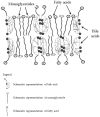Features of Lipid Metabolism Disorders in Primary Biliary Cholangitis
- PMID: 36551803
- PMCID: PMC9775928
- DOI: 10.3390/biomedicines10123046
Features of Lipid Metabolism Disorders in Primary Biliary Cholangitis
Abstract
Primary biliary cholangitis (PBC), previously known as primary biliary cirrhosis, is an autoimmune liver disease that mostly affects women. A progressive disorder in the processes of bile secretion and enterohepatic bile salts circulation in patients with PBC already in its early stages, leading to an insufficient release of bile acids into the bowel and their entry into the systemic circulation. Insufficient bile acids released into the duodenum contributes to the development of malabsorption, energy malnutrition, and slowly progressive weight loss. The pathophysiological mechanisms of weight loss and its slow progression are associated with the deterioration of the fat emulsification processes and with the reduced absorption of hydrolyzed products, such as fatty acids and monoglycerides, with steatorrhea in patients with PBC, as well as in those with gut dysbiosis. Just in the early stages of the disease, this results in accelerated fatty acid β-oxidation that is aimed at compensating for progressive energy malnutrition. The entry of bile acids into the systemic circulation in PBC is accompanied by dyslipidemia. The mechanism of hyperlipidemia in patients with PBC differs from that in other conditions because along with an increase in total cholesterol (TC), there are elevated high-density lipoprotein levels and the appearance of unusual lipoprotein X (Lp-X). The appearance of Lp-X is most likely to be the body's protective reaction to inactivate the detergent effect of bile acids on the membrane structures of blood corpuscles and vascular endothelial cells. It is bile acids, rather than TC levels, that correlate with the content of Lp-X and determine its formation. Concomitant hypercholesterolemia in patients with PBC is also aimed at neutralizing the detergent effect of bile acids that have entered the systemic circulation and is most likely a compensatory reaction of the body. "Anomalous" hypercholesterolemia in PBC can serve as a model system for the search and development of new methods for the treatment of dyslipidemia since it occurs without an increase in the incidence of cardiovascular events.
Keywords: dietary lipid metabolism disorders in PBC; hypercholesterolemia; mechanism of dyslipidemia in PBC; primary biliary cholangitis (PBC).
Conflict of interest statement
The authors declare no conflict of interest.
Figures



Similar articles
-
Bile acid therapy for primary biliary cholangitis: Pathogenetic validation.World J Exp Med. 2025 Mar 20;15(1):101771. doi: 10.5493/wjem.v15.i1.101771. eCollection 2025 Mar 20. World J Exp Med. 2025. PMID: 40115760 Free PMC article. Review.
-
Gastric Xanthomatosis Secondary to Lipoprotein X in Primary Biliary Cholangitis.J Investig Med High Impact Case Rep. 2022 Jan-Dec;10:23247096221089488. doi: 10.1177/23247096221089488. J Investig Med High Impact Case Rep. 2022. PMID: 35403472 Free PMC article.
-
Serum metabolic profiling of targeted bile acids reveals potentially novel biomarkers for primary biliary cholangitis and autoimmune hepatitis.World J Gastroenterol. 2022 Oct 21;28(39):5764-5783. doi: 10.3748/wjg.v28.i39.5764. World J Gastroenterol. 2022. PMID: 36338890 Free PMC article.
-
S100 calcium binding protein A6 and associated long noncoding ribonucleic acids as biomarkers in the diagnosis and staging of primary biliary cholangitis.World J Gastroenterol. 2021 May 7;27(17):1973-1992. doi: 10.3748/wjg.v27.i17.1973. World J Gastroenterol. 2021. PMID: 34007134 Free PMC article.
-
Impact of Microbes on the Pathogenesis of Primary Biliary Cirrhosis (PBC) and Primary Sclerosing Cholangitis (PSC).Int J Mol Sci. 2016 Nov 9;17(11):1864. doi: 10.3390/ijms17111864. Int J Mol Sci. 2016. PMID: 27834858 Free PMC article. Review.
Cited by
-
Primary biliary cholangitis: A historical perspective from xanthomatous lesions to modern molecular biology.World J Gastrointest Pathophysiol. 2025 Jun 22;16(2):107347. doi: 10.4291/wjgp.v16.i2.107347. World J Gastrointest Pathophysiol. 2025. PMID: 40568038 Free PMC article. Review.
-
Cholesterol-modified prognostic nutritional index as an independent prognostic biomarker in primary biliary cholangitis patients.BMC Gastroenterol. 2025 May 30;25(1):421. doi: 10.1186/s12876-025-04013-8. BMC Gastroenterol. 2025. PMID: 40448036 Free PMC article.
-
Development and external validation of an early prediction model to identify irresponsive patients and prognosis of UDCA treatment in primary biliary cholangitis.Sci Rep. 2024 Dec 28;14(1):31369. doi: 10.1038/s41598-024-82854-1. Sci Rep. 2024. PMID: 39732944 Free PMC article.
-
Multi-omics approaches for drug-response characterization in primary biliary cholangitis and autoimmune hepatitis variant syndrome.J Transl Med. 2024 Feb 29;22(1):214. doi: 10.1186/s12967-024-05029-6. J Transl Med. 2024. PMID: 38424613 Free PMC article.
-
Concurrent nonalcoholic fatty liver disease may decrease liver fibrosis severity in patients with primary biliary cholangitis.BMC Gastroenterol. 2025 Jul 30;25(1):541. doi: 10.1186/s12876-025-04145-x. BMC Gastroenterol. 2025. PMID: 40739215 Free PMC article.
References
-
- Shamshtein D., Liwinski T. Pathogenesis and management of fatigue in primary biliary cholangitis. Fatigue Biomed. Health Behav. 2022;10:1–25. doi: 10.1080/21641846.2022.2034473. - DOI
-
- Vieira Barbosa J., Vionnet J., Sciarra A., Sempoux C., Aubert V., Moradpour D., Fraga Christinet M. Primary biliary cholangitis: An update. Rev. Med. Suisse. 2018;14:1489–1494. - PubMed
Publication types
LinkOut - more resources
Full Text Sources

